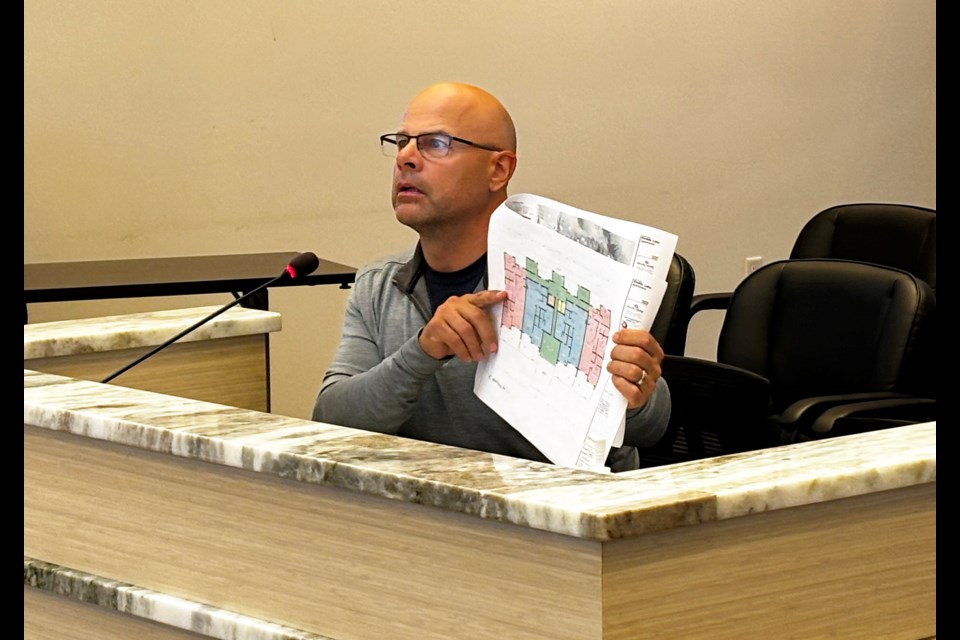INNISFAIL – Glen Carritt’s ambitious plan to build a multi-million dollar, 12-unit seniors’ condo project along the northeast shore of Dodd’s Lake is another step closer to being realized.
On Aug. 6, Innisfail’s Municipal Planning Commission (MPC) approved a staff recommendation to officially grant the former town councillor and businessman a development permit for his plan to construct a 20,000-square foot condo building with a parking garage on vacant property at 5052 - 59th Street.
MPC’s approval came with two conditions, with the first being a commitment of a specified setback from the top of the lake’s bank to the condo building, and the second having minimum landscaping area requirements.
The 1.5-acre property at this location has been owned by Carritt for about five years.
With the formal approval of the development permit Carritt must now wait until the end of a 21-day appeal period before moving on a building permit for the condo project that has an estimated value of about $5 million.
“We'll work on the building permit, and we've got all the geographical drawings coming as we speak. So yes, we're hoping to get going by the end August,” Carritt told the Albertan after the MPC meeting.
In the meantime, Carritt was pleased he moved successfully through the development permit process.
“I think it went well. I think the town is excited for this development, and I think they're willing to work with us on getting it moving forward,” said Carritt.
Once successfully constructed, Carritt’s new housing project for seniors 55 and over will be next to the planned mega-development by Evertrust (Innisfail) Inc. on 136 acres of farm land above the north and northeast shorelines of Dodd’s Lake.
As noted in the staff report to MPC, Carritt’s property has been the subject of several past land use amendments.
The most recent amendment occurred earlier this year when it was changed from Residential Single Family District (R-1B) to Residential Multi-Family District (R-3) in anticipation of the current development application.
The report, presented to MPC by Crystal Chappell, development officer for the Town of Innisfail, said the area is now a mixture of low density single detached and semi-detached dwellings to the south of the property, farmland to the north and east, and Dodd’s Lake to the west.
MPC members were told Carritt’s proposed development consists of a three-storey building containing 12 suites, with four on each floor.
The 12 suites, which are considered “mid- to high-end”, are a mix of two single-bedroom units with a den, eight two-bedroom suites and two three-bedroom units. They range in size between 1,215 and 1,365 square feet.
Carritt’s plan also includes a detached building to be used for parking with each unit having a parking stall. There are also an additional 17 surface stalls.
During the meeting staff told MPC that the developer would be responsible for additional fees, including $14,565.57 in offsite levies, which can be paid at the time of the building permit.
As well, under the Rates and Fees Bylaw the developer is required to pay a landscaping deposit of $10,000, which is payable at the time the development permit is issued and refundable when a final inspection is completed by the town.
And a development deposit of $1,000 is also required.
Carritt asked administration if he would also be responsible for the potential cost of a water main tie-in to the north of his property.
Gordon Shaw, manager of community development for the Town of Innisfail, said staff would work with him on the issue and further discussions would take place during the development agreement process.
“The trade off here is that if we didn't have that extension of the water main then you would be responsible for looping the water,” Shaw told Carritt. “What we're trying to do is save the applicant money by extending that water main to the north side and then having it be tied in when the development to the north happens.”
Following the meeting Carritt told the Albertan that questioning the additional expenses was important, as the “bottom line” is every extra cost that goes into the project’s development increases the cost of each unit.
“Because we have to recoup that cost, right? Every little bit that we can save on each unit then the cost will be able to be kept down for the purchasers,” said Carritt, adding despite the challenges he is “enjoying” the process. “You work through all the loops and jump through the hoops and get ‘er going.”



